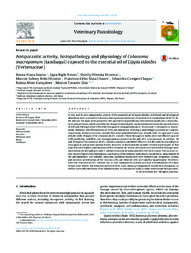Antiparasitic activity, histopathology and physiology of Colossoma macropomum (tambaqui) exposed to the essential oil of Lippia sidoides (Verbenaceae).
Antiparasitic activity, histopathology and physiology of Colossoma macropomum (tambaqui) exposed to the essential oil of Lippia sidoides (Verbenaceae).
Author(s): SOARES, B. V.; NEVES, L. R.; FERREIRA, D. O.; OLIVEIRA, M. S. B.; CHAVES, F. C. M.; CHAGAS, E. C.; GONÇALVES, R. A.; TAVARES-DIAS, M.
Summary: In vivo and in vitro antiparasitic activity of the essential oil of Lippia sidoides and blood and histological alterations were assessed in Colossoma macropomum (tambaqui). Essential oil concentrations of 10, 20, 40, 80, 160 and 320 mg/L were assayed in vitro against monogenoideans Anacanthorus spathulatus, Notozothecium janauachensis and Mymarothecium boegeri from fish gills. Lippia sidoides essential oil concentrations of 320 and 160 mg/L were 100% effective against monogenoideans in 10 min and 1 h of exposure, respectively. However, the effectiveness of 100% concentrations of 80 mg/L and 40 mg/L occurred in 3 and 6 h, respectively. In the in vivo tests, juvenile fish were submitted to 60 min of baths with 10 mg/L and 15 min of baths with 20 mg/L of the essential oil of L. sidoides. These therapeutic baths were not efficient against Ichthyophthirius multifiliis, and monogenoideans present in the gills of C. macropomum. In addition, 10 and 20 mg/L of the essential oil of L. sidoides caused an anesthetic effect on the fish and did not influence total glucose and protein plasma levels; however, it decreased the number of total erythrocytes in fish exposed to the higher concentration of this essential oil. Severe alterations and irreversible damage were observed in the fish gills just after L. sidoides essential oil baths and after 24 h of recovery. The most recurrent lesions found were hyperplasia and fusion of the lamellar epithelium, vasodilation, detachment of the gill epithelium and lamellar aneurism, epithelial breakdown with hemorrhage, congestion, edema and necrosis, proliferation of the mucous cells and chloride cells and lamellar hypertrophy. Therefore, since the essential oil of L. sidoides has in vitro antiparasitic activity and low concentrations of it have shown toxic effects, the bioactive potential of its main chemical components should be investigated, as well as more efficient forms of its administration in therapeutic baths in order to eliminate fish parasites.
Publication year: 2017
Types of publication: Journal article
Unit: Embrapa Amapá
Keywords: Blood, Freshwater fish, Medicinal plant, Parasite, Parasito, Peixe de água doce, Planta medicina, Sangue
Observation
Some of Embrapa's publications are published as ePub files. To read them, use or download one of the following free software options to your computer or mobile device. Android: Google Play Books; IOS: iBooks; Windows and Linux: Calibre.
Access other publications
Access the Agricultural Research Database (BDPA) to consult Embrapa's full library collection and records.
Visit Embrapa Bookstore to purchase books and other publications sold by Embrapa.

